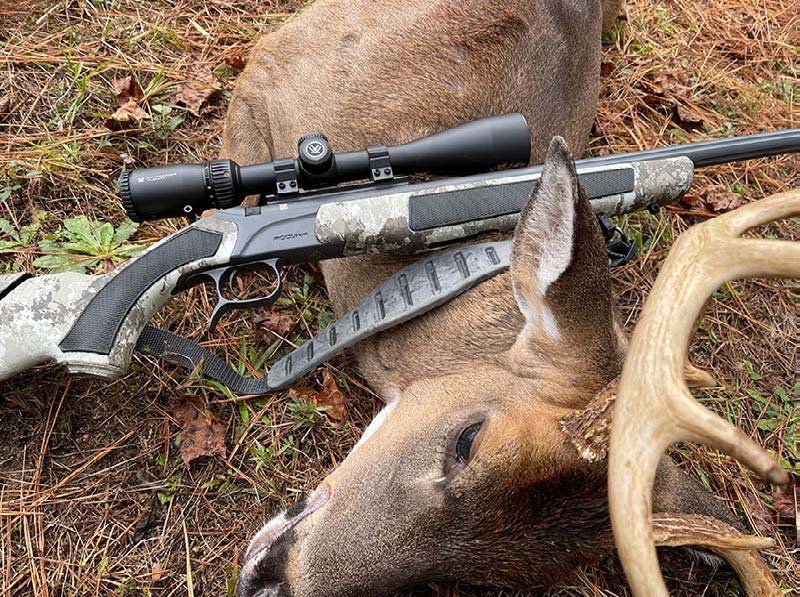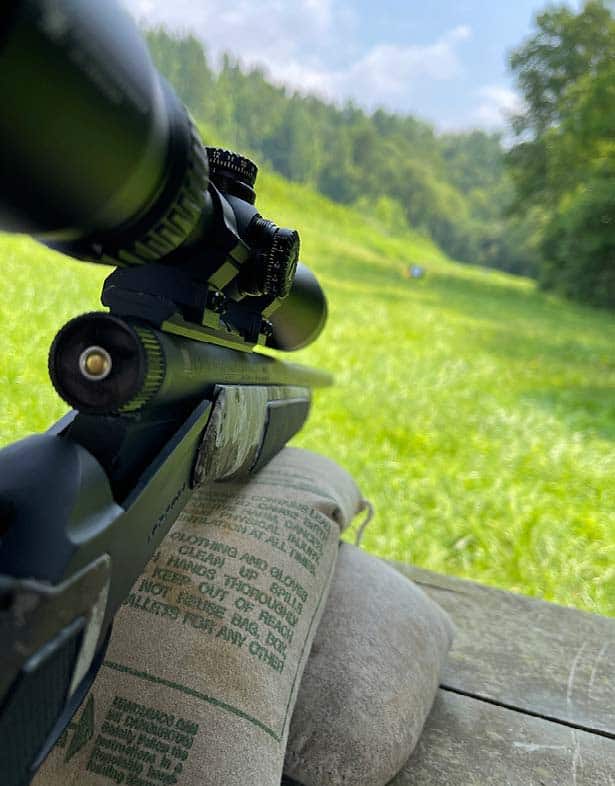The evolution of muzzleloader enthusiasm exploded in 1985 when Tony Knight, of Knight Muzzleloader fame, designed and implemented an idea to improve on what was an old weapon.
Knight’s idea was to improve the ignition system to generate a more consistent ignition. To accomplish this, he completely redesigned the ignition system, moving it from a sidelock (where the spark would have to travel a distance while turning 90 degrees in the process) to a straight (or inline) ignition system. In doing so, the modern muzzleloading era began.
Since that time, more and more designers, engineers, and gunsmiths have tinkered with the muzzleloading rifle. The result has been nothing short of phenomenal. Everything about it has changed—from the ignition systems to the stocks, barrels, triggers, and ramrods. You name it, and it has been changed, upgraded, and improved.
Industry Leader
Since Knight Industries, no other company has led the way more than CVA when it comes to ingenuity, accuracy, and efficiency in the modern muzzleloader. Ever since the dawn of the rifle, accuracy and consistency have been the driving forces for hunters. That’s been true from the days when they hunted for their next meal to today’s chase for bigger and faster game with our muzzleloaders.
We all want to get the most out of our rifles. So, let’s look at some things that can help you improve your accuracy and performance.
The first point is obvious: you need a high-quality rifle with quality components. CVA has long been the industry leader when it comes to accuracy, efficiency, and the highest-quality components in the game. That being said, let’s break it down to the hunter and shooter levels.

Break or Bolt Action
For most hunters, there are two actions to consider when looking at a modern muzzleloader— break action and bolt action. Break action is by far the most common, so will be the key focus of this article.
When ignition systems advanced from the old no.11 percussion caps to using a 209-shotgun primer as the ignition source, the once-common misfire was alleviated. The 209-shotshell primer is almost foolproof in its consistency to work when called upon. Using a 209-shotgun shell primer as its ignition source, the 209 inline muzzleloader is one of the best advances in modern muzzleloading. The consistency and availability (usually) of the 209 primer make it a preferred choice for most muzzleloading hunters who use a break-action rifle.
Pellets vs. Powder
When it comes to accuracy, that begins with the powder. For convenience, many hunters choose to use the Pyrodex pellets. These pre-formed black powder substitutes are certainly easy and foolproof in many areas. But what they gain in convenience, they lack in consistency, and thereby, accuracy.
Most of the pellets from Pyrodex are manufactured in specific sizes. For example, the .50 caliber pellets are packaged and come in 50-grain individual pellets. This means you’re forced to shoot either 100 or 150 grains of powder in your rifle.
While either of these is fine, they are not the optimal charge for your rifle to get the best performance. Will it do? Yes. Is it the best? No. To achieve the most consistent accuracy at moderate and long-range shots in your muzzleloader, hunters and shooters should consider switching from pre-formed pellets to loose powder. Thankfully, there are many options to choose. (WARNING! Never shoot anything except black powder or black powder substitutes in your muzzleloading rifle.)

Powder Load
Many hunters and shooters will opt for the maximum load in their rifles, which, in most cases, is 150 grains in a .50 caliber rifle. However, while a rifle will shoot it, that is not going to perform at its best at those charges. Liken this to your truck or vehicle. The speedometer may say 120 miles per hour, and while it may actually achieve 120, the best performance is achieved at somewhere closer to 65 to 70 mph. The same is true for your muzzleloading rifle. It may shoot 150 grains, but the most optimal performance is achieved at much lower levels.
Powder Test Outcomes
Testing done by the author and others has shown that one powder stands above the rest when it comes to consistency and accuracy. Blackhorn 209 Black Powder substitute is an excellent choice. This non-corrosive black powder substitute has achieved a level of consistency and accuracy not seen before in muzzleloading rifles. The added benefit of being noncorrosive means I do not have to clean my rifle after each shot. Some tests have shown that it’s possible to shoot as many as 30 to 40 times between cleanings. For me personally, that is a complete game-changer.
The advantage of shooting loose powder is that you can measure to the exact grain for the most consistent loads in your rifle. In my CVA Accura .45 caliber, I use my RCBS electronic powder scale to measure Blackhorn 209 by weight.
Many other hunters have switched from the volume measuring system of old to weight measuring in order to gain consistent shooting. By determining that the most consistent powder measure for my rifle is 75 grains, I can achieve a 200-yard zero on my .45 caliber Accura. Conversely, in my .50 caliber, I discovered that 110 grains is the sweet spot for shooting sub MOA groups at 100 yards. Choosing loose powder allows shooters to design the powder charge that is best for the desired distances and animals they are hunting.

Choosing Projectiles
After settling on powder, the next items to consider are the projectiles. From the old round balls, to cast bullets, to today’s ballistic-tipped, copper-jacketed projectiles, the ability to achieve the desired effect downrange has never been more available.
Tony Smotherman is known by many as a true muzzleloading legend. Joining Knight Muzzleloaders in the beginning, Smotherman has hunted across the country for nearly three decades with a muzzleloading rifle in his hands. Now, as head of Influencer Relations for BPI Outdoors, Smotherman knows a thing or two about muzzleloaders in general and projectiles in particular.
“The evolution of the projectile in the muzzleloading world is perhaps the last and biggest thing to come in recent memory,” Smotherman says. “When we developed the ELR projectile in the Powerbelt line, we changed the game for long-range accuracy.”
The completely redesigned projectile of the ELR is allowing hunters to get sub-MOA accuracy out of their muzzleloaders on a consistent basis. A mass-produced muzzleloader has not been able to shoot beyond 300 yards with consistency, until now. When you can combine the accuracy of the rifle with a good charge of loose powder and the best projectile on the market, hunters are seeing groups at ranges never realized beforehand.
The ELR is available in .40, .45, and .50 caliber versions for a variety of rifles. These bullets can be shot in any muzzleloading rifle of the correct caliber.
As Smotherman puts it, “We are living in the good old days of modern muzzleloading.”
The ability to get the most out of your rifle is easier than it’s ever been. In testing at the Talladega Marksmanship range, I was able to consistently hit steel targets out to 600 yards with my CVA .45 caliber Accura muzzleloader. All this was achievable because of the combined components in my rifle.

Specific Optics
Having the best gun, best ignition, powder, and projectile is only part of the game. If you cannot see your target, it is all for naught. Choosing the best optics for your muzzleloading rifle can be overwhelming, given so many options. But to clarify one thing from the onset, it is not recommended that you use a BDX reticle in your muzzleloading rifle.
BDX reticles are designed for specific loads and bullets. You are limited on what you can use and achieve when you use these optics. They may be fine in a centerfire rifle, but when it comes to muzzleloaders, it is recommended that you stick with a standard single reticle.
Accuracy with optics begins with the base and nothing is more consistent than a picatinny rail for the base of your optics. The rail allows the rings to sit tight and prevents any movement in the alignment. Having a rail to mount your optics will help eliminate any further issues.
As for which scope or what kind? That is like trying to convince a Ford guy to buy a Ram; it is a personal preference. Having said that, I have found one thing consistent in my optics choices: the size, weight, and magnification.

Selecting Magnification
For my modern muzzleloading rifles, my preference goes to either a 44 or 50mm objective with an adjustable magnification ranging from 3×9 to, in some cases, a 4×16. Obviously, for the longer-range options, the 4x16x50 is suited for more open long shots.
Some of the better brands I have used on my CVA muzzleloaders include Hawke and Vortex. The Hawke Sidewinder scopes are ideally suited for the long-range muzzleloader. With the adjustable turrets, you can dial in your calibrations with precision.
The Vortex Crossfire is another excellent choice for your muzzleloader. Available in 3x9x44 and 6x24x50, the Crossfire is a preferred choice by many muzzleloading hunters.
As you can see, getting the most from your muzzleloader is not as difficult as it may seem. Does it take some time? Yes. Will it make you a better hunter and shooter? Absolutely. As hunters and shooters, we owe it to ourselves and to the animals we pursue to get the most from our rifles as we can. It enhances the experience of the hunt and builds confidence in our rifles and our abilities. When it matters most, we know it will get the job done.
_________________________________
Ready to upgrade your hunting gear? Our gear reviews will give you the information you need to make the best choices!
Per our affiliate disclosure, we may earn revenue from the products available on this page. To learn more about how we test gear, click here.



